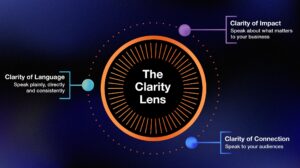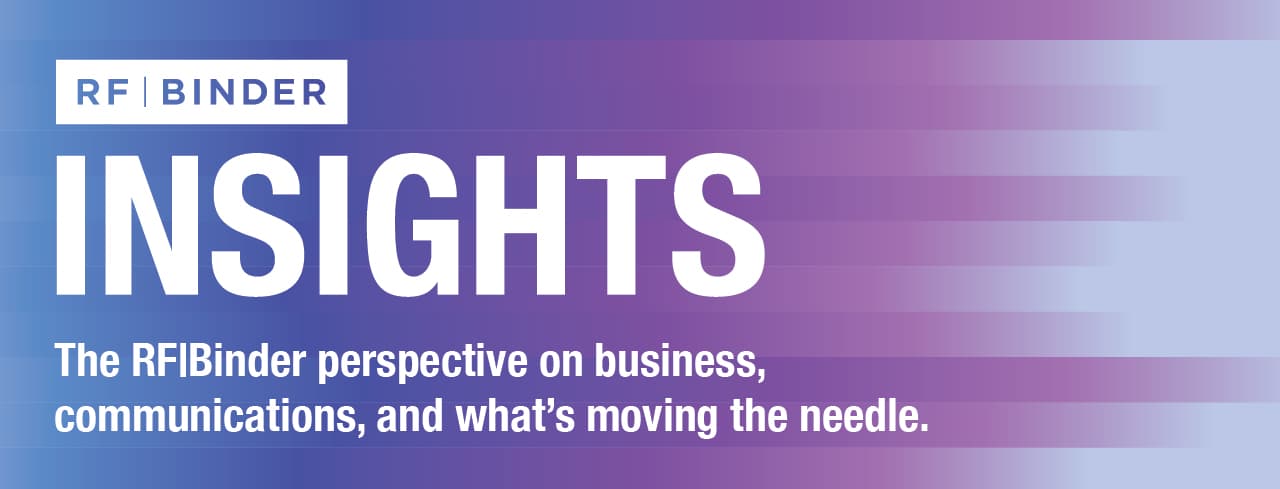This is the second piece in a three-part series about RF|Binder’s new strategic framework: The Clarity Lens™. You can find the first part here and the third part here.
In our last post, we took a first look at RF|Binder’s Clarity Lens, and we discussed how “Clarity” can help forge a powerful alignment between your business strategy and your communications strategy. Now, we’ll take a look at what exactly we mean by “Clarity.”
In the context of the Clarity Lens, we typically mean three things when we say “Clarity” – each of which should be considered carefully when evaluating and improving the effectiveness of your communications strategy:

Clarity of Impact: Aligning Communications and Business Strategies
The central tenet of the Clarity Lens is that every element of your communications strategy must be aligned with business objectives. And further, that your business strategy must be informed by communications insights.
Let’s start with the first half: At the highest level, everything about your communications strategy – your core messaging, your communications channels, your target audiences, your calls to action, etc. – must be directly connected to your organization’s business objectives. Any communication that does not directly support your organization’s business objectives – whether it’s a talking point, a social media post, a press release, or your organization’s core mission statement – should be reconsidered.
But at the same time, the Clarity Lens must be a two-way street: Communications strategists and the insights they bring should play a critical role in shaping your organization’s business strategy.
Communications strategists are continuously mining for insights. We have our finger on the pulse of what’s being said by influencers, journalists, consumers, financial analysts and other key stakeholders across social media and the news media. We’re keenly aware of which stories, angles and messages resonate, and which ones will be greeted with skepticism or worse. We understand the importance of listening and making decisions based on data that we collect.
Those insights are critical in shaping communications strategies (e.g., Should we be using terms like “sustainability” and “ESG,” or just talk about how and why we’re using less water and energy? Do our target customers want to be hearing from us on Instagram or TikTok?), but they’re also critical to informing business strategy, assessing risks, and protecting your brand (e.g., Can we be confident that our target customer segment will respond positively to our upcoming merger? Should we take legal action against a high-profile critic, or will that hurt our reputation and our bottom line?).
“Clarity of Impact” means you’ve established a positive feedback loop between your organization’s communications and business strategies – thereby enabling each to inform the other in real time, and optimizing both.
Clarity of Connection: Understanding Your Audiences
Once your communications strategy is fully aligned with your business strategy, the next step is to consider who you’re speaking to.
Different audiences are motivated by different messages, stories, channels and values. And while that’s easy to remember in a vacuum, it can be easy to overlook in practice – particularly when pivoting to a new target audience, or when interacting with an intermediary audience like a journalist or another “influencer.” In our experience, some of the most impressive companies that offer some of the most impactful products or services can sometimes be the ones who are most likely to neglect their audiences’ perspectives (“We know how great our product is, so of course our potential customers will see it, too!”). Every communications program should begin with the question: Who am I speaking to?
Ultimately, any organization that seeks to develop compelling communications needs to understand what issues, messages and messengers their audiences will find compelling. This means understanding your audiences’ expectations, assumptions, needs, desires, fears, and more. It means understanding how their perspectives could be changing, or how they could potentially change as your organization’s communications and business strategy evolves. For this reason, the Clarity Lens pays close attention to who your audiences are, what they’re already thinking and feeling, and how to most effectively tailor our communications to reach them and resonate with them.
This component of the Clarity Lens is helpful for avoiding pitfalls and misunderstandings, but its real value is in building meaningful connections with your audiences. By understanding your audiences and stakeholders, you have an opportunity to step outside of your own intentions and assumptions, and instead to focus on the needs and expectations of those audiences and stakeholders. That could mean recontextualizing your messages in a new way to ensure they resonate, or it could mean developing entirely new strategies to more effectively address your audiences’ needs.
Clarity of Language: Directness, Simplicity and Consistency of Communications
In many respects, this is the component of the Clarity Lens that most directly reflects the average person’s concept of “clarity.” Clarity of Language means intentional simplicity. It means saying what we mean, saying it succinctly, and doing whatever we can to eliminate confusion.
But in the context of the Clarity Lens, it also means ensuring consistency and establishing a cohesive voice and identity across all modes of communication. It means striving for clarity in all “languages” you employ – not just in written and spoken language, but in your use of visuals, graphic design, presentation logic, and more.
Finally, as “Clarity of Language” dovetails with the other elements of the Clarity Lens, it takes on additional weight. It doesn’t just mean using plain, common language that’s readily accessible to all audiences – it means using the language that will resonate with your specific target audiences, and motivate them to take the actions that will further your organization’s business objectives.
In our experience, most organizations are already thinking about at least some of the elements that we prioritize in the Clarity Lens, but few are acting on all of them.
How well is your organization delivering on these three components of the Clarity Lens? Are there changes you could make to ensure you’re always communicating as directly as possible, discussing your purpose-related work in a manner that can foster real trust, and building meaningful connections with your audiences? If you’re unsure, don’t hesitate to reach out to a member of our team to learn more.
Up next: How it comes to life.

